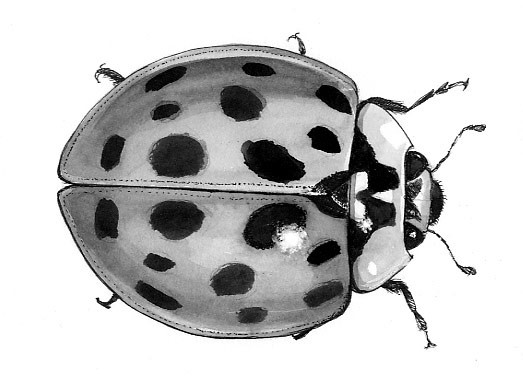
Who loves a ladybug? Until recently, everyone did. These tiny beetles gobble aphids and other soft-bodied insects that plague crops and ornamental plants.
It is said that their name refers to the Virgin Mary, to whom our European ancestors gave thanks for the beetles that saved their crops. They are also called lady beetles. In Britain, they are called ladybirds or ladybird beetles. For centuries, they were thought of as bringers of good luck. In Iran, they are called “Good News.”
As far as we know, the name has nothing to do with feminine characteristics. There are, indeed, gentleman ladybugs. Ladybugs share a basic body plan with their fellow beetles, which includes the wings that let them “fly away home.” It’s the hard forewings that give a ladybug its shell-like covering. The large, membranous hindwings underneath unfold and are used for flying.
The high-water mark for ladybug love may very well have been in 1977, when the New Hampshire legislature named the two-spotted ladybug as that state’s official insect. (Massachusetts, Ohio, and Tennessee had already made ladybugs their state insects.) In 1989, New York designated the widespread and common nine-spotted ladybug as its state insect..
There are some 450 native species of ladybug in North America and several thousand species in the world. New Hampshire has about 60 native species within its borders, and Vermont has about 40. Almost every one of those species is a beneficial insect, eating plant pests that we might otherwise use chemicals to kill.
But sometime in the 1990s, the worm, or maybe in this case the larva, began to turn. (Ladybug larvae are spiky-looking things, often equal in size to mom and dad.) Ladybugs have always overwintered as adults in large groups, sometimes even in people’s houses. As the 1990s went on, more and more people in the eastern, mid-western, and northwestern U.S. were complaining about hundreds or thousands of ladybugs entering their homes in the fall.
While the two-spotted, native ladybug had always done this to some extent, the new culprit was the multicolored Asian lady beetle (Harmonia axyridis), also known as the Halloween ladybug. This ladybug is a tree-dweller, originally from Asia, and it comes in a variety of shades, from yellow to orange to red.
This ladybug had been intentionally released time and again – in Georgia, Ohio, and Washington – throughout the 1970s as a natural predator of crop pests. When few of these ladybugs were recaptured, it was thought they were dying out. Instead, they had just flown away to new homes. The good news is that these ladybugs did such a number on the pecan aphids in Georgia that chemical pesticides are no longer used for aphids there. The bad news is that every fall, Halloween ladybugs find their way into American homes, sometimes in horror-movie-like numbers.
Ladybugs don’t eat while inside your house, and they don’t reproduce there. They are just seeking a warm place for the winter, which may be a small solace when you find one doing the backstroke in your coffee.
The bugs can be kept out by tightly sealing your house, including putting screens over all roof, attic, and wall vents. If they are already inside, ladybugs can be sucked up with a vacuum cleaner that has a nylon stocking inserted into the extension wand. The ladybugs that get in your house are usually non-native and, quite obviously, overabundant, so do with them what you will.
Just don’t crush them. They stain. And don’t eat them.
“They taste horrible, which is part of their natural defense and why many of them are brightly colored – an example of aposomatic (warning) coloration,” says John Weaver, who, as an entomologist with the New Hampshire Department of Agriculture, I trust did not arrive at this knowledge through his own experience.
He says that wine makers have found that when Halloween ladybugs get harvested with the grapes, the crushed beetles taste so bad that they can ruin the wine.
We won’t be rid of the Halloween ladybug any time soon, but we may have learned our lesson. Weaver reports that “the U.S. Department of Agriculture seems to have adopted new guidelines in selecting lady beetles for introduction, selecting species that are specialized predators and not selecting species that are generalized predators.”
Introduced ladybug species don’t just bug humans. They impact other ladybugs as well. New York hasn’t seen its state insect – the nine-spotted – in years. It’s believed that a different introduced species, the seven-spotted ladybug, may have done it in either by eating it or by out competing it.
It’s a little harder to love a ladybug these days, but it’s a little harder to be one, too.

